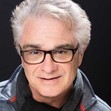Gerald Everett Jones's Blog: Gerald Everett Jones - Author
November 20, 2025
Three Writers Who Changed My Life
Oh yes, I do read other writers—especially their books—and I sometimes review them here. I tend to avoid critical remarks and point out themes that are intriguing, inspiring, and illuminating.
I’d welcome your comments on what you have discovered and admire about these three authors.
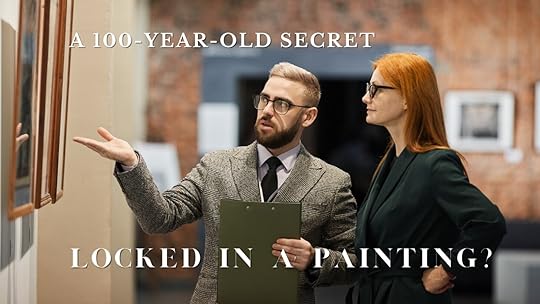

Thinking About Thinking is a reader-supported publication. To get podcasts, interviews, and audiobooks, consider becoming a paid subscriber.
November 5, 2025
Two Words That Worry Me a Lot
“That’s over and done with,” you might say. It was a scam. It was tried and tested in court.
“It’s not something I ever needed to worry about.”What if tomorrow you saw the headline:
Trump University Exonerated!You may be concerned, as I am, that this business model, if not by the same name, has already been resurrected.
Consider the Facebook ads I’m seeing (because I have certain health concerns):
New cure for tinnitus without prescription drugs!
Don’t eat these three foods or you’re at risk for cancer!
This secret formula can regrow cartilage!
Your health is at cancer risk unless you follow these three steps!
This superfood will lower your blood pressure!
Don’t let your dog eat this!
If you get hooked by any of this click-bait come-ons, you will:
Watch a 20-minute video that never discloses the answer to the headline until the very end.
End up in a pitch for a bottle of pills, composed of an exotic blend of rare, highly refined Amazonian plants.
Feel so lucky you saw this before the Government wiped it from all websites because they DON’T WANT YOU TO KNOW.
If you have second thoughts or want confirmation, you will be presented with a web page of information that cites 30-50 research white papers in its footnotes. If you are so enterprising as to click any of those sources, you will find a possibly legitimate medical research study, which relates, however distantly, to the topic, but offers no substantiation to the specific claims or product made in the pitch,
When the Federal Trade Commission and the Federal Drug Administration disappear or are weakened, there will be no credible experts to warn us about bogus claims and products. (There will still be some in the EU - go there!)
So when you see an ad like this, just think of those two chilling words:
“Trump University!”
Oh, and if the Federal Department of Education disappears, scholastic standards will revert to the states, the quality and credibility of which may vary, depending on how much the electorate is willing to spend on schools (maybe, not much). Consider the following hypothetical Teacher Certification Test, which has only two questions:
Are you over the age of 18?
Do you pledge unreserved support of ___________________?
If ou answered YES to both questions! Congratulations!You are now a CERTIFIED TEACHER in the State of ___________________.Here’s a fictionalized story about the first wrongful death case ever brought against the LAPD—1981. George Floyd died much the same way. Not much has changed.

Thinking About Thinking is a reader-supported publication. Upgraded (paid) subscribers can access all archived posts, including audiobook episodes, podcasts, and full-text book releases (from the Podcast and Archive menu tabs).
November 2, 2025
Curious About What All You Get with Paid?
Paid subscribers to Thinking About Thinking sign up for five bucks per month or thirty per year, which may be canceled at any time.
Archived content hides out behind the Thinking About Thinking Podcast, GetPublished! Radio Episodes, and Archive menu tabs on the home page.
So — for the sake of (no) argument, you could sign up for just a month and get all this. Or hang out longer and digest it more slowly.
We could make a pitch that you’d also be supporting free expression, indie publishing, and creative careers.
But self-interest isn’t a bad reason.
1. Romantic comedy - all chapters.2. Literary fiction - all chapters (text).3. Mystery-thriller - all chapters.4. Thoughtful interviews5. PodcastsPlus:Book reviews
Essays
Book discounts
Thinking About Thinking is a reader-supported publication. Upgraded (paid) subscribers can access all archived posts, including audiobook episodes, podcasts, and full-text book releases (from the Podcast and Archive menu tabs).
October 5, 2025
Replay 'My Perfect Romance'
Two sessions - the Ladies Who Lunch chat cheerfully among themselves, review Harry Harambee’s Kenyan Sundowner, and dish about me in my absence. In another session, they ask me questions, most of which were not embarrassing.

Click here to replay!



Thinking About Thinking is a reader-supported publication. Upgraded (paid) subscribers can access all archived posts, including audiobook episodes, podcasts, and full-text book releases (from the Podcast and Archive menu tabs).
October 1, 2025
Book Review - 'Finding My Bones' by Quinne Brown Huffman
Quinne Brown Huffman’s book is a lifelong reflection to the point of embracing her purpose, summoning courage and enthusiasm for her next steps. The title might imply finding her roots, which she does recounting formative events of her childhood, tweens, teens, and motherhood. But it’s also a process of growing a spine as an adult — and as the winged image on the cover suggests — taking flight as she celebrates her uniqueness as an individual as well as her mission as an active member of community.
“Following the path of least resistance” might seem to go counter to purposeful living, but for Quinne it’s about maintaining a mindset, being open to possibilities that are greater than you can imagine or specify. When you realize the value of unexpected opportunities, you can embrace them.
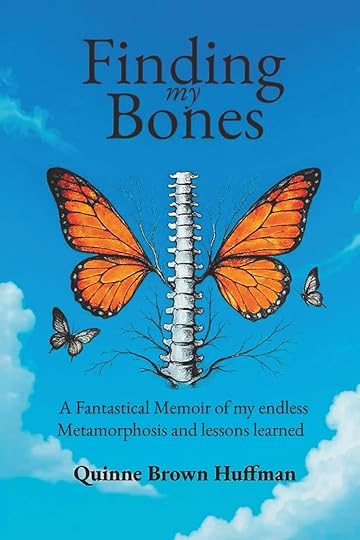
Finding My Bones: A Fantastical Memoir of My Endless Metamorphosis and Lessons Learned by Quinne Brown Huffman
Her story tells of her childhood in South Africa, along with family outings there, then her own adventures “collecting my bones” in London, Glasgow, San Francisco, and returning trips to South Africa. Today, she is a practitioner of metaphysical and healing arts, recently settled with her family in Southern California.
The heart of her emergence has been the transformative experiences of childbirth and motherhood, which she has extended as a doula and compassionate counselor.
Her storytelling waxes poetic at times, and the shifts to what reads like free verse are seamless. So, it’s lyrical. (Perhaps she will sing the audiobook?)
It’s a delight and an inspiration. I suspect she might have written it for her daughters, but consider yourself a family member.

Find Quinne Brown Huffman on Substack here @quinne, and as well as minding the store at Sunset Park Provisions in Santa Monica.
Thinking About Thinking is a reader-supported publication. To access podcasts, audiobooks, and premium content, consider becoming a paid subscriber.
September 24, 2025
Guest Post: My Perfect Romance
Book club party cohosts Val, Courtney, & Lisa review the tender-hearted novel Harry Harambee's Kenyan Sundowner, which tells the story of a lonely widower’s “second-chance romance.”
The My Perfect Romance podcast discusses all things romance — they discuss books, movies, and interview real couples as well.
It’s set in the intriguing locale of a luxury seacoast resort in Kenya.
But perfect? Hardly. Harry worries:Is corruption a fact of life everywhere?
Is all love transactional?
Am I being scammed? (If I’m enjoying myself, should I care?)
Am I a tourist or a citizen?

These ladies are having great fun. You’re a fly on the wall. They get only slightly more serious when eventually they start talking about the book.
These three stifled their giggles just long enough to introduce Gerald for a soul-searching interview:
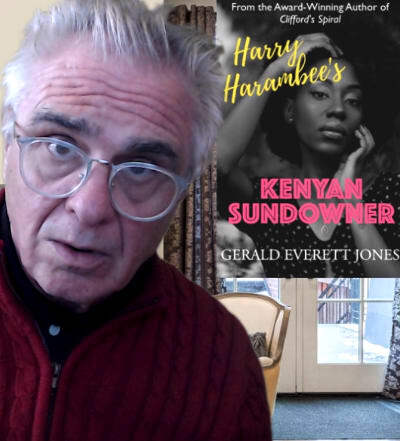

The author reluctantly admits that Harry’s misadventure is a fictionalized memoir, but he refuses to say which incidents actually happened to him when he lived for two years in Kenya.

Harry Harambee’s Kenyan Sundowner is available in paperback, Kindle/EPUB, and audiobook (on Audible, Apple, Google Play, BN, Kobo, and other popular platforms).
Thinking About Thinking is a reader-supported publication. To get podcasts, interviews, and audiobooks, consider becoming a paid subscriber.
September 21, 2025
Book Review - 'The Not-So Only Child' by Rich Boerner
Rich had been talking to me about the book he wanted to write for what seemed like a very long time. Recently, the improvements in audio transcription software made it possible for him finally get it done. As he describes it:
So, veteran broadcaster Rich Boerner had his audiobook “in the can” before he had a manuscript. The story goes:“For ten years I tried (and failed) to write this book, until a good friend told me to just do what I do for a living. Talk. Tell the story into a microphone. And transcribe it later. So that’s what I did.”
When he boarded a flight to New York, it wasn’t just to mourn his mother—it was to unearth the truth about his entire life. He takes his audience on a heart-stirring and often hilarious journey through grief, memory, and stunning personal revelation. What begins as a bittersweet mission to clean out his late mother’s apartment quickly transforms into a life-redefining odyssey, as long-buried family secrets begin to rise to the surface—one box, one drawer, one photo at a time.

The Not-So Only Child: My True Story by Rich Boerner (YourStorybyYou.com).
Told with warmth, self-deprecating humor, and unflinching honesty, Rich revisits his childhood as a self-proclaimed only child, raised by a spirited single mother in a cramped Queens apartment. Through deeply personal anecdotes, he shares the tender joys of a mother-son bond steeped in musical theater, baseball games, and private jokes—an oasis of love in his otherwise male-absent world. But when an unexpected discovery reveals his late mother’s secret romance with a long-time coworker, Rich is forced to reconsider everything he thought he knew about his father—and himself.
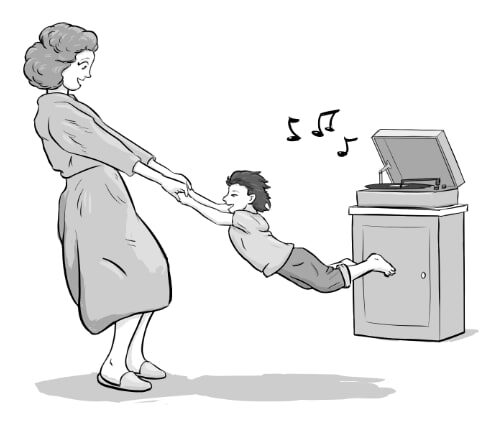
Rich’s mom shared her enthusiasm for music, dance, and baseball with him. (Book illustrations by Dr. Christopher Zeineh.)
As he navigates the emotional chaos of this revelation, Rich stumbles into something even more unimaginable: a sibling he never knew existed. Through a series of letters, chance emails, and transcontinental phone calls, Rich builds a connection with his newfound sister, a woman who grew up just a few miles—but a whole world—away. Their unfolding relationship adds a new layer to Rich’s journey of self-understanding and familial connection, showing how sometimes the truth we seek arrives decades late, but just in time.
Rich's voice, rooted in his career as a radio professional and audio storyteller, lends a distinct cadence to this memoir—like sitting across from a friend who makes you laugh while breaking your heart. The Not-So Only Child is a celebration of the redemptive power of truth, the resilience of love, and the beautiful, chaotic mess that is family. It reminds us that life doesn’t always give us neat answers—but when it does, they often come wrapped in the most unexpected packages.
About the AuthorRich Boerner is a Webby, NAACP Image, and Broadcast Radio Award-Winning Audio Creator / Producer / Talent whose successful journey has taken him to Los Angeles, San Francisco, New York, and Orlando. His resume includes working for and with A-List talent and major networks, including Spotify, Audacy, FOX, and CBS Radio. Rich has also been the voice of several regional and national ad campaigns. Boerner also directed and co-created a film-fest honored web TV series, and as a youth, cohosted the first national Cable TV Pay-Per-View Concert, featuring Ozzie Osbourne.
He’s most proud of, and impressed by, his three children. Grateful to be able to spend his days with his golden-hearted wife.
Finally, as a champion of the underdog, Rich continues to be deeply obsessed with The NY Mets, NY Jets, and LA Clippers.
Thinking About Thinking is a reader-supported publication. To get premium content, such as podcasts, interviews, and audiobooks, consider becoming a paid subscriber.
September 17, 2025
Book Review - 'The Secret of Secrets' by Dan Brown
I hold Dan Brown in high respect. If you have viewed my interviews posted here, I have extolled the wisdom of his advice:
Keep making promises to the reader.
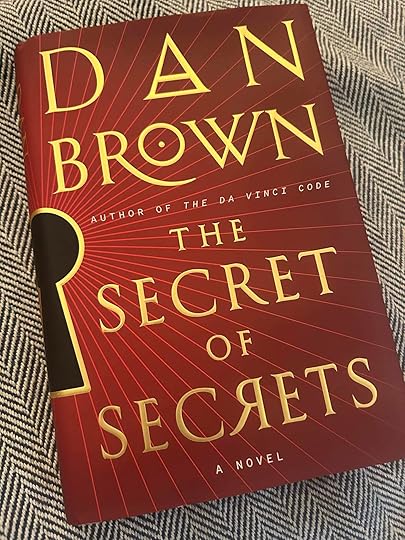
The Secret of Secrets: A Novel by Dan Brown (Doubleday)
He shares this advice in his Masterclass interview. Before I saw that session, I assumed he would be coaching writers on how to craft cliffhangers, of which he is a master. True, he did. But wrong, his advice wasn’t about cornering protagonists in locked rooms and devising clever means of escape. Those latter examples I call “Bulldog Drummond” perils. The (male) hero and his (usually female) sidekick get trapped in a closed room. In one episode of the famous old movie serial, the walls are moveable and begin to close in, threatening to crush them. In other plots, water begins to flood the space, and there is no apparent way out.
Thinking About Thinking is a reader-supported publication. To receive new posts and support my work, consider becoming a free or paid subscriber.
Nevertheless, Dan Brown is a master at crafting those kinds of scenes. And these tight situations inspire the “eye-candy” that makes patrons of movie thrillers breathless.
The revelation promised by The Secret of Secrets title will be hardly a surprise to students of recent scientific theory. Brown does not save the reveal to the very end. No, he repeats it early and often: “Consciousness is nonlocal.”
What does nonlocal mean?
Nonlocal is a technical term now used widely among theoreticians to describe physics that are not well understood, nor explainable by empirical means in a contained local environment. Among researchers in neuroscience, the controversial split is between materialist and noetic explanations of human consciousness. Materialists such as Ray Kurzweil, preeminent researcher at Google and author of the recent book The Singularity Is Nearer, nothing goes on in a human brain that can’t eventually be explained by local physical processes. So, if you build a computer that is complex enough, it will become conscious. Therefore, everything humans experience—our thoughts, our emotions, and even our sense of the timeless—occurs entirely within our own skulls.
A contrary view is expressed by the noetic scientists, typified by neurologist Christof Koch in his book The Feeling of Life Itself. Koch believes he’s investigated all possible local processes in the brain that could produce what we experience subjectively as consciousness. He finds no satisfactory explanation by applying laws of physics as presently understood. He speculates, therefore, that consciousness may be a pervasive and fundamental property of the universe. All sentient beings share in this experience to the extent that our individual bandwidth of perception permits.
Fundamental. Universal. Shared. That’s the meaning of nonlocal.
And not just Koch. None other than preeminent linguist and semantic theoretician Noam Chomsky speculates that the origin and inheritance of language is nonlocal—not arising simply from complexity of brain structure—but somehow received as shared intelligence, perhaps from what Carl Jung called the collective unconscious. Chomsky’s cohort of theoreticians contend they can be specific about when humans began to speak—about 125,000 B.C., among primitive Bushmen-Pygmy groups.
And music and dance came first! Then not speech—but clicks!
Now to the spoiler. Hang on to your topknot lest you blow your lid:
Ultimately—hardly a surprise considering the novel’s genre—the secret is the way nonlocal consciousness has been, perhaps is being, exploited by the three-letter intelligence agencies.
Fans of Dan Brown will understand that he is not only a consummate storyteller—he is also a pundit and a prophet. In his The Da Vinci Code, his villain is a follower of the secretive Catholic cult Opus Dei. Few news feeds will tell you that Leonard Leo, the billionaire who helped pack the Supreme Court, is a follower of that organization, as are several members of the high court. In Brown’s Inferno, years before the outbreak of Covid, he describes a worldwide pandemic unleashed by a research scientist who fears the main threat to human extinction is overpopulation.
In the frontmatter to The Secret of Secrets, Dan Brown states emphatically:
All artwork, artifacts, symbols, and documents in this novel are real.
All experiments, technologies, and scientific results are true to life.
All organizations in this novel exist.
Be afraid? Be very afraid?
Buddhist masters will perhaps claim that nonlocal consciousness is no new discovery.
But the notion that human brains are receivers rather than generators of our experience will be a revelation to the rest of us.
Dan Brown was a student of Phillips Exeter Academy, an exclusive private school where his father taught mathematics. Like J. K. Rowling, who studied classics at university, Brown was schooled in “dead white men’s literature.” These days, young scholars may encounter this tradition only in their novels.
Brown’s advice to continually make promises to the reader is basic. End a chapter when a question arises and before you give the answer. The reader will expect to get a reward by turning the page.
Remarkably, the chapters in this novel are short, scarcely more than a few pages. There are 141 of them (including Prologue and Epilogue). Just right for snagging the next promise while waiting for a bus or your food.
If I have a complaint about Brown, whether in this one or in his body of work, it’s his belaboring of those perilous Bulldog Drummond situations.
But, hey, those action sequences are the favorite fodder of moviemakers. Enjoy! (Just don’t expect the movie to venture very far into the deeper stuff.)
As of this writing, checking IMDBPro, the novel is not yet in preproduction. Don’t doubt it will be!

How about a dose of theology and metaphysics with your crime?
Thinking About Thinking is a reader-supported publication. To receive premium content such as podcasts, interviews, and audiobooks, consider becoming a paid subscriber.
August 2, 2025
'Mysterious Radio' Asks the Preacher

Mysterious Radio with KTown website
Our discussion of this conspiracy theory led back to the Church Comission investigations of the early 1960s and a well-documented plot to overthrow Fidel Castro with a spectacular false-flag operation.
Rumors abound today about Project Blue Beam, presumably a secret NASA program.
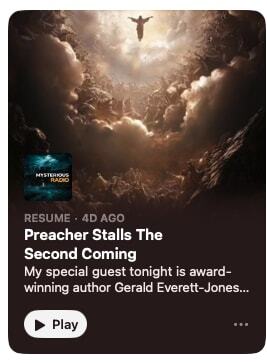
My wide-ranging talk with KTown touched on all kinds of Deep State gossip - including how to hide the truth by publicizing it shamelessly - which figures strongly in the plot of Preacher Stalls the Second Coming, fourth novel in the Preacher Evan Wycliff mystery series.
KTown offered the insight that warnings in fiction should command our attention as much or more than stories in the 24/7 news cycle.
For example, did you know that Dan Brown warned us about Covid in his novel Inferno - published years before anyone but scientists thought a worldwide pandemic was a serious and imminent threat?

Have you been waiting for the audiobook?Winner of BookFest Gold and New York City Big Book Silver - in Mystery.
Among my fourteen novels, Harry Harambee’s Kenyan Sundowner might be my sentimental favorite. I figured, “Hey, I’m an experienced podcaster. I can narrate this!”
Arduous lessons learned. But I’m very proud of the result. Released through distributors worldwide just last month.

Second-chance romance? Harry Gardner wonders why they tease him with the nickname “Harambee,” and he frets about whether he will be a tourist or a citizen.
You may have noticed that the text chapters of Clifford’s Spiral - serialized on this site for Paid subscribers - just concluded. You can find all chapters on the Home page of Thinking About Thinking. Find previously serialized audiobooks on the Podcast tab.
Thinking About Thinking is a reader-supported publication. To access premium content such as serialized audiobooks, consider becoming a paid subscriber.
July 27, 2025
Clifford's Spiral: Chapter 23
In Clifford's Spiral, the stroke survivor’s past is blurry, and his memories are in pieces. He asks himself:
Who was Clifford Olmstead Klovis?
Chapter 23Stroke sufferer Clifford Klovis tries to piece together the colorful fragments of his memories. What’s left for Clifford?
How to get Myra to care deeply for him — the problem burned in Clifford’s brain more than the structure of the universe or the nature of consciousness. More than the meaning of spirals or the elegance of math. Those questions were mind games for geeks. Admittedly, he was one. Or had been. But who would pay attention to him now, even if he could or would speak? Other more accomplished theorists would get Nobel prizes for puzzling it all out someday.
He thought the spiral thing was important. Hawking said the notion of the corkscrew could have made a difference way back when. But mathematics must have evolved well enough, having progressed according to a different point of view from the one Clifford was suggesting. After all, this math got astronauts to and from the tiny International Space Station with regularity.
Hawking surely had it right about women, though. Make the lady laugh. You didn’t need to be a Nobel winner to figure that one out. But — break his vow of silence? Language would be essential, fundamental, to any successful plan. Fart sounds and burps might amuse but wouldn’t get him the quality of attention he craved.
The question was now unavoidable — could Clifford speak if he wanted to?
He had told himself he’d been withholding speech. It took a Herculean strength of will to resist the diagnostic prodding and poking, to remain passive and unresponsive to all those cleverly devised stimuli.
Have I outwitted their tests or simply failed them?
* * *

